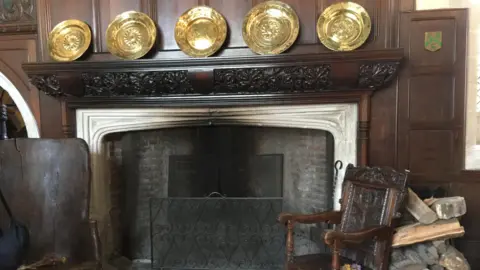Records reveal 'incredible' details about 17th Century
 Hearth Tax Digital
Hearth Tax Digital"Remarkable" tax records that offer "an incredible amount of information" about life in the 17th Century have been uploaded online for the first time.
The deeds show information about the infamous hearth tax, which charged households for the number of fireplaces they had.
Below we take a look at the tax's importance and how the records have now resurfaced.
To ensure households did not lie about the number of hearths, people were paid to monitor their neighbours' records, and Dr Andrew Wareham, from the University of Roehampton which has been running the national project, said "the level of intrusiveness was something which would never be achieved again".
Dr Andrew added: "It gives you an insight into what is happening at street level in the 17th Century."
Several counties across the UK have had records put up online as part of the university's digitisation project, with Wiltshire's records dating back the furthest.

Dr Wareham said: "What was slightly weird about the 17th Century was that it was your local neighbours who did the tax collection as a kind of part-time job almost."
They were told to collect a lot of information as well about their neighbour's everyday lives.
Dr Wareham described the records as "remarkable".
"It's a unique short period where the state captures this incredible amount of information about every household," he added.
 Steve Hobbs
Steve HobbsIn order to understand the records, Steve Hobbs, retired archivist from Wiltshire, has been painstakingly transcribing them for months.
Mr Hobbs had to compare other old records with names to make sure things matched up correctly, including looking at small strips of parchment called "membranes".
The most hearths he has come across is 78, which was for Ramsbury Manor. However, water damage means that it is a mystery how many other grand houses had, including Longleat.
Mr Hobbs explained that the records are interesting for showing wealth, but also individuals names for family historians to track and the history of the houses.
"If you found, say, their probate records, which might have an inventory of their belongings, you can link the two together. So it's an important resource," he said.
 Andrew Wareham
Andrew WarehamNationally, the most hearths on one place found so far was 1,700 in Hampton Court Palace in Richmond-upon -Thames- but that did not have to pay tax as it belonged to royalty.
The tax was not cheap - two shillings per hearth per year, which was the equivalent of a days pay for a skilled tradesman.
Households with rent less than 20 shillings a year did not have to pay it, but even with this stipulation, inspectors found that some were just unable to pay.
Most people only had a couple of fireplaces, which were central to the home for cooking, warmth and light.
 Andrew Wareham
Andrew WarehamThere was opposition to the tax - collectors decided not to argue when the Head of the Royal Armoury did not let them in to check the fireplaces.
However, the richer members of society were not always amenable - large urban houses were often found not to pay while those in the countryside would.
Aristocratic families would say the house in the country was the main residence and refuse to pay in the city.
There were other ways that people would try to get around it - including blocking up their hearths, something Dr Wareham explained was a "serious sacrifice" during a time we now see as one of the "little ice ages" so it was even colder in winter than usual.
Follow BBC Wiltshire on Facebook, X and Instagram. Send your story ideas to us on email or via WhatsApp on 0800 313 4630.
